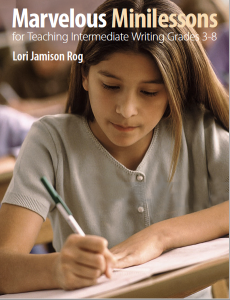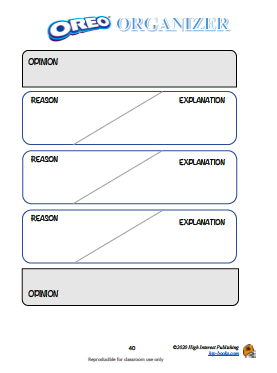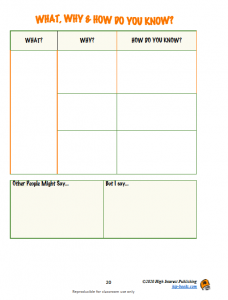INTRODUCING OPINIONS
A complete unit on Teaching Persuasive Writing may be found in Marvelous Minilessons for Teaching Intermediate Writing by Lori Jamison Rog, Pembroke Publishers, 2018.
I Hate Detentions!
I believe teachers shouldn’t give detentions when kids are late! I have three good reasons why. First, sometimes teachers are late, and they just walk in like nothing happened and say, “Sorry I’m late.” Then when we come in late they say, “I will see you at lunch.” or, “Why are you so late?” That’s not fair, and it’s a double standard. Second, detentions are a huge waste of time. For example, if you are done everything and you get a detention for being late, you have to sit in an empty room for 15 minutes. Fifteen minutes doesn’t sound like much. But it is if you are not doing anything. Third, my sister is really, really slow and my mom and dad make me wait for her, so she makes me late. Therefore, when I’m late because of her, it’s really not my fault! For all of these reasons, I believe teachers should not give detentions because we are late.
– Grade 6 student
If there’s any doubt about how pervasive persuasion is in our society, we have only to look at the number of words we have in English to describe the action of trying to bring someone around to one’s point of view, such as coax, cajole, convince, entice, entreat, exhort, impel, influence, inveigle, persuade, prevail upon, reason, seduce, sell, sway, talk into, turn on to, wear down, wheedle, win over, and woo!
The print around us is full of persuasion, from the Opinion Section of the newspaper to grocery flyers and advertisements. And in this era of “fake news”, it’s particularly important for readers to be able to judge when and how a writer is trying to influence their thinking.
Teaching students to write persuasive text is a great way to help them read it as well. The essay above, “I Hate Detentions” is a good example of classically structured opinion writing from a sixth grader.
The best way to start any genre writing unit is to analyze examples of the text form. Use the student example above or download “A Battle Against Bottled Water” or gather samples of your own. With the students, discuss how these passages are organized. What do they have in common? Are there any writer’s techniques to influence the reader? Read more about THE FEATURES OF PERSUASIVE TEXT.
When students understand the elements of the text form and its unique rhetorical devices, they can begin writing their own persuasive pieces.
TEACHING PERSUASIVE WRITING
1. Start with an opinion or thesis. Have students choose topics that matter to them. There are plenty of issues that impassion middle and high school writers, from cell phones in school to animal welfare. With the students, brainstorm a selection of issues and invite the students to select one or two that speak to them.
2. Plan the body of the piece: arguments and explanations. It’s important for students to learn to develop a thesis, build arguments and provide supporting evidence. Writers shouldn’t support an opinion with an opinion; they need outside evidence to back up their ideas. That means they might need to conduct some research to support their reasons with examples, facts, statistics and quotes from experts. The OREO ORGANIZER (Opinion – Reasons – Explanations – Opinion) pictured on the right is a good tool for planning the body of a piece of persuasive writing.
3. Anticipate the argument. An effective way to convince readers of an opinion is to guess what they might be thinking – and refute their arguments upfront. Putting oneself in the reader’s head can be a challenge for young writers, but it sometimes helps to approach it as “Other people might say…but I say…”, as is found in the WHAT, WHY AND HOW DO YOU KNOW? planner.
4. End with a “call to action.” A great way to end a piece of persuasive writing is by inviting the readers to be part of the opinion or the solution. Pronouns like WE and YOU are effective tools for bringing the reader into the piece, for engaging them in the topic and for inviting them to be part of the solution.
5. AIM for a great beginning. It’s often easier to plan the opening of the piece after the body and conclusion are done. It’s not enough just to state the opinion or topic sentence. Grab the reader’s ATTENTION, provide some background INFORMATION, and give the MAIN POINT.
6. Revise for clarity and craft. When writers are satisfied with what their writing says, they need to pay special attention to how it is said. Hold peer (and/or teacher) conferences to make sure the writing is clear and makes sense to a reader. This is a good point at which to teach various elements of writer’s craft that make persuasive writing more – well, persuasive. Rhetorical techniques for persuasive writing include:
-
- MAGIC OF THREE
- LOADED WORDS
- POWERFUL PRONOUNS – YOU, ME & WE
- VARIED SENTENCES: statements, questions, exclamations and commands
7. Polish to Publish. This is the point at which spelling, capitalization, grammar and punctuation – the “conventions” of language – should be corrected. The writing should be as clean as possible for the reader to navigate, so the reader can focus on the content rather than struggling to decode the errors.
“Some people argue that bottled water is healthier and tastes better than tap water. Actually, much of the water that we buy in bottles is really just tap water! …In most places, tap water is more carefully checked for bacteria than bottled water is…” – A Battle Against Bottled Water
“So the next time you want to take a drink to the beach, on a run, or for a ride in the car, grab a reusable bottle and fill it from the kitchen tap. You’ll be doing some good for your body, your wallet, and the earth.” – A Battle Against Bottled Water
“Try to picture 30 billion plastic bottles. That’s five times as many bottles as there are people in the entire world. And that’s how many bottles of water North Americans buy every year. Unfortunately, most of those bottles will end up in landfills or the ocean. This is just one of the reasons why it’s time to stop using plastic water bottles.” – A Battle Against Bottled Water




